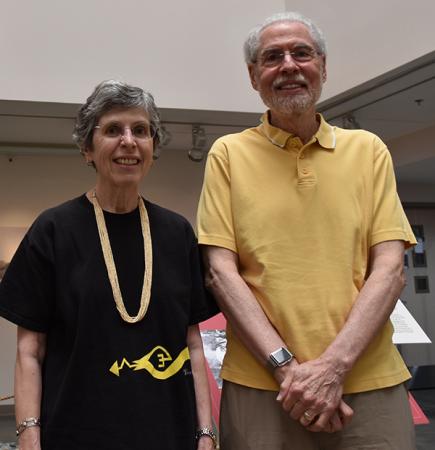
Type: DonorVolunteer
Level: Curator's Circle
“We feel places such as the Maxwell are important intellectually and culturally. Understanding what other cultures do can be an incentive to improve one's own. When one grows up in a culture, there is a tendency to think it is the best, or only, way things should be done. Exposure to other cultures provides insight and opportunity for change. It is critical to understand how other cultures organize themselves to maintain their existence. The Maxwell is a key contributor to that understanding."
Lou and Hank Schuyler began vacationing out west in the 1980s, visiting New Mexico and much of the Southwest. Career professionals in the New York City area, Lou worked in information technology and Hank in advertising.
In retirement they wanted to live somewhere with a milder climate, but with access to the arts and services they enjoyed in New York, without the winters and crowds. Albuquerque was appealing for its cultural institutions, such as the University of New Mexico, the Santa Fe Institute, the Outpost Performance Space, and all the terrific local museums. They decided to relocate to Albuquerque in 2004. Art, research, and fiber arts, are their passions - now Hank is a painter and poet and Lou a fiber arts enthusiast and archaeology researcher.
“The connections that you make here are astounding,” said Hank, and Lou adds: “We’ve met a lot of people from all over the place, who have moved here to become part of the intellectual and artistic communities."
Their participation in the Maxwell Museum started in 2004 with Lou's interest in archaeology. Although she had no prior academic or professional experience in the field of archaeology or anthropology, her skill set was a match. "During our trips, we attended one of the Edaakies' Indian Bread Baking events (Mary Jane and Robert Edaakie served Indian Tacos and fresh oven bread for many years), and a lecture on obsidian given in the Anthropology building," said Hank. "We had already visited the Maxwell." Lou's interest in archaeology led to her volunteer work in early 2005. Curator of Archaeology David Phillips (now retired), gave her a tour of ongoing volunteer effors and she chose and archiving project to get started. Three years later, he encouraged her to research the jewelry in the Maxwell collections from Tijeras Pueblo and contribute a paper to the Maxwell Technical series. Lou agreed and has been contributing since then. "I've found the learning experience is a very productive way to spend time, working both from home and at the Museum, studying artifacts, reading through documents, and writing up what I've found."
“Volunteer work has become a significant activity for me and I feel like I’m making a contribution to the body of knowledge, having published reports in the Technical Series," says Lou.
Her papers:
No. 15, The Jewelry of Tijeras Pueblo
No. 18, Jewelry from LA 46316, the Correo Shrine Site, Valencia County, New Mexico
No. 20, A Guide to Collections and Proveniences for Pottery Mound
No. 26, The Jewelry of Pottery Mound, with a Comparison to Tijeras Pueblo
No. 32, Archaeological Studies at Comanche Springs and Metzler Ruin Valencia County, New Mexico: an Overview
Lou and Hank Schuyler have generously supported the Museum with annual donations matched by a former employer. Their support through the years has benefitted archaeological research and education.